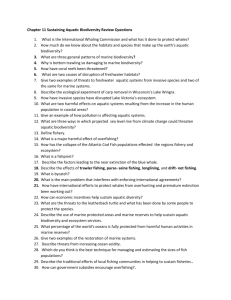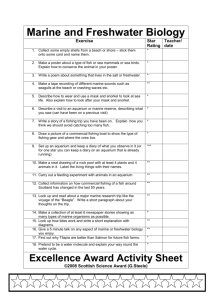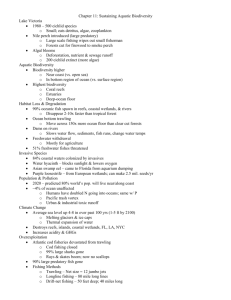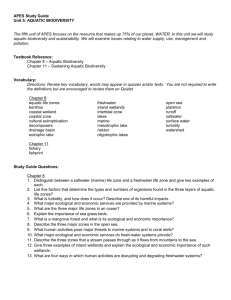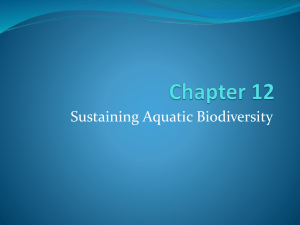Population Growth and Pollution Can Reduce Aquatic Biodiversity
advertisement
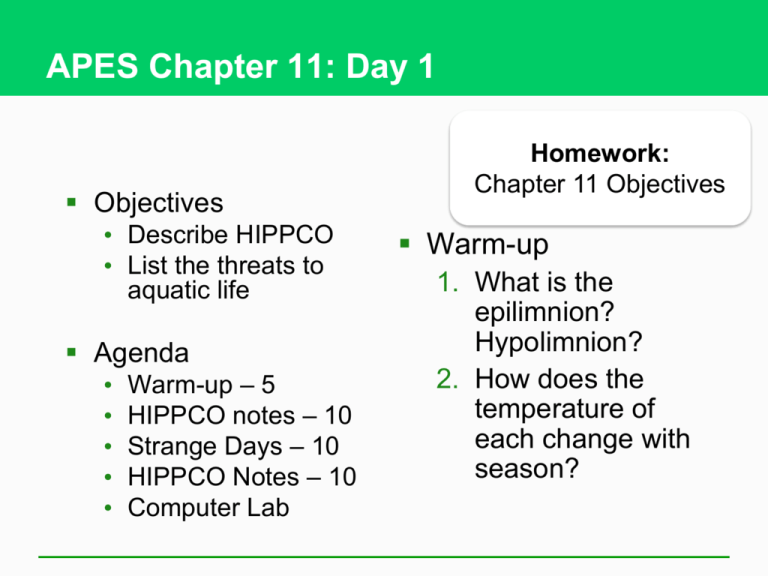
APES Chapter 11: Day 1 Objectives • Describe HIPPCO • List the threats to aquatic life Agenda • • • • • Warm-up – 5 HIPPCO notes – 10 Strange Days – 10 HIPPCO Notes – 10 Computer Lab Homework: Chapter 11 Objectives Warm-up 1. What is the epilimnion? Hypolimnion? 2. How does the temperature of each change with season? Sustaining Aquatic Biodiversity Chapter 11 Core Case Study: A Biological Roller Coaster Ride in Lake Victoria Shallow lake in East Africa • 500 species of fish found nowhere else Nile perch: deliberately introduced • Loss of biodiversity and cichlids (“SIK-lids”) • Increased poverty and malnutrition • Depleted forests (to preserve fish oil) Core Case Study: A Biological Roller Coaster Ride in Lake Victoria Frequent algal blooms • Nutrient runoff • Spills of untreated sewage • Less algae-eating cichlids 11.1 What are the major threats to aquatic biodiversity? We Have Much to Learn about Aquatic Biodiversity Greatest marine biodiversity • Coral reefs • Estuaries • Deep-ocean floor We have explored 5% of the global ocean! Biodiversity is higher • Near the coast than in the open sea • In the bottom region of the ocean than the surface region Human Activities Are Destroying and Degrading Aquatic Habitats Habitat loss and degradation H I P P C O • Marine • Coastal pollution and tourism • Ocean floor: effect of trawlers • Freshwater • Dams • Excessive water withdrawal Science Focus: Protecting and Restoring Mangroves Protect and restore mangroves • Reduce the impact of rising sea levels • Protect against tropical storms and tsunamis • Cheaper than building concrete sea walls • Mangrove forests in Indonesia Natural Capital Degradation: Area of Ocean Bottom Before and After a Trawler Invasive Species Are Degrading Aquatic Biodiversity Invasive species H I P P C O • Threaten native species • Disrupt and degrade whole ecosystems • 84% of world’s coasts are being colonized by invasive species Invasive Species Are Degrading Aquatic Biodiversity Three examples H I P P C O • Water hyacinth: Lake Victoria (East Africa) • Asian swamp eel: waterways of south Florida • Purple loosestrife: indigenous to Europe • Treating with natural predators—a weevil species and a leafeating beetle—Will it work? Science Focus: How Carp Have Muddied Some Waters Lake Wingra, Wisconsin (U.S.): eutrophic • Contains invasive species • Purple loosestrife and the common carp increase turbidity Dr. Richard Lathrop • Removed carp from an area of the lake • This area appeared to recover • More photosynthesis Population Growth and Pollution Can Reduce Aquatic Biodiversity Nitrates and phosphates mainly H from fertilizers enter I water P P C O • Leads to eutrophication Toxic pollutants from industrial and urban areas Population Growth and Pollution Can Reduce Aquatic Biodiversity Nitrates and phosphates mainly H from fertilizers enter I water P P C O • Leads to eutrophication Toxic pollutants from industrial and urban areas Climate Change Is a Growing Threat Global warming: sea levels will rise and H aquatic biodiversity is I threatened P P C O • Coral reefs • Swamp some lowlying islands • Drown many highly productive coastal wetlands • New Orleans, Louisiana, and New York City Video Clip Strange Days on Planet Earth – Dirty Secrets • Bleaching the Reef Overfishing and Extinction: Gone Fishing, Fish Gone Marine and freshwater fish H I P P C O • Threatened with extinction by human activities more than any other group of species • Modern industry can cause 80% depletion of target species in 10-15 years Commercial extinction – occurs when it is no longer profitable to continue fishing an affected species Overfishing and Extinction: Gone Fishing, Fish Gone H I P P C O Bycatch – nontarget species caught in fishing • Comprises almost 1/3 of world’s annual fish catch Case Study: Industrial Fish Harvesting Methods Trawler fishing • Dragging funnel shaped nets held open at the neck along ocean bottom • Weighted down with chains or metal plates • Newer nets are large enough to swallow 12 jumbo jet planes! • Catch shrimp, cod, flounder, and scallops Case Study: Industrial Fish Harvesting Methods Purse-seine fishing • Spotter plane locates school of fish • Vessel encloses it with large net • Catch surface dwelling species (tuna, mackerel, anchovies, and herring) • Dolphins frequent bycatch Case Study: Industrial Fish Harvesting Methods Longlining • Putting out lines up to 80 miles long with baited hooks • Adjustable depths • Frequent bycatch (sea turtles and seabirds) Case Study: Industrial Fish Harvesting Methods Drift-net fishing • Fish caught by huge drifting nets • Hang as deep as 50 feet below surface • Extend 40 miles long • 1992 UN ban on use of nets longer than 1.6 miles Major Commercial Fishing Methods Used to Harvest Various Marine Species 11.2 11-2 How Can We Protect and Sustain Marine Biodiversity? Concept 11-2 We can help to sustain marine biodiversity by using laws and economic incentives to protect species, setting aside marine reserves to protect ecosystems, and using community-based integrated coastal management. Legal Protection of Some Endangered and Threatened Marine Species Why is it hard to protect marine biodiversity? • Human ecological footprint and fishprint are expanding • Much of the damage in the ocean is not visible • The oceans are incorrectly viewed as an inexhaustible resource • Most of the ocean lies outside the legal Case Study: Protecting Whales: A Success Story… So Far Cetaceans: Toothed whales and baleen whales • Bite and chew food vs. filter feeders 1970: U.S. • Stopped all commercial whaling • Banned all imports of whale products 1986: moratorium on commercial whaling • Pros? Cons? Tourism… Norwegian Whalers Harpooning a Sperm Whale Examples of Cetaceans Examples of Cetaceans Individuals Matter: Creating an Artificial Coral Reef in Israel Reuven Yosef, Red Sea Star Restaurant • Coral reef restoration • Reconciliation ecology • Treatment of broken coral with antibiotics Case Study: Holding Out Hope for Marine Turtles Carl Safina, Voyage of the Turtle • Studies of the leatherback turtle Threats to the leatherbacks • Trawlers • Pollution • Climate change Communities protecting the turtles Marine Sanctuaries Protect Ecosystems and Species Offshore fishing • A country’s offshore fishing zone extends 20 statute miles from its shores • Exclusive economic zones – foreign ships may extend into foreign waters when given governmental permission • High seas – free for all! Law of the Sea Treaty – coastal nations have jurisdiction over 36% of ocean surface and 90% fish stocks Marine Sanctuaries Protect Ecosystems and Species Marine Protected Areas (MPAs) – areas of ocean partially protected from human activities • • • • 4, 000 nationwide 200 US Only partially protected Harmful human activities still illegally occur Establishing a Global Network of Marine Reserves: An Ecosystem Approach Marine reserves – fully protected! • Closed to • Commercial fishing • Dredging • Mining and waste disposal • Core zone • No human activity allowed • Less harmful activities allowed • E.g., recreational boating and shipping Establishing a Global Network of Marine Reserves: An Ecosystem Approach Fully protected marine reserves work fast • • • • Fish populations double Fish size grows Reproduction triples Species diversity increase by almost one-fourth An Atoll of Australia’s Great Barrier Reef 11.3 11-3 How Should We Manage and Sustain Marine Fisheries? Concept 11-3 Sustaining marine fisheries will require improved monitoring of fish populations, cooperative fisheries management among communities and nations, reduction of fishing subsidies, and careful consumer choices in seafood markets. Estimating and Monitoring Fishery Populations Is the First Step Maximum sustained yield (MSY): traditional approach; maximum amount of fish that can be harvested annually without causing a population drop • Difficult to estimate population size and growth rate Optimum sustained yield (OSY): takes into account interactions among species Estimating and Monitoring Fishery Populations Is the First Step Multispecies management: also incorporates competitive and predator-prey interactions Large marine systems: using large complex computer models **Precautionary principle: sharply reducing fish harvest and closing some overfished areas until they recover • Need more information about what levels of fishing can be sustained Government Subsidies Can Encourage Overfishing 2007: World Trade Organization, U.S. • Proposed a ban on fishing subsidies Reduce illegal fishing on the high seas and in coastal waters • Close ports and markets to such fishers • Check authenticity of ship flags • Prosecution of offenders Some Countries Use the Marketplace to Control Overfishing Individual transfer rights (ITRs) • Control access to fisheries • Government gives each fishing vessel owner a specified percentage of total allowable catch (TAC) for a give year • New Zealand and Iceland • Difficult to enforce Problems with the ITR approach • Illegally exceeding quotas • Difficult to enforce Consumer Choices Can Help to Sustain Fisheries and Aquatic Biodiversity 1997: Marine Stewardship Council (MSC), London • Supports sustainable fishing • Certifies sustainably produced seafood Manage global fisheries more sustainably • Individuals • Organizations • Governments Solutions: Managing Fisheries Video Clip Strange Days on Planet Earth: Baboons 11.4 11-4 How Should We Protect and Sustain Wetlands? Concept 11-4 To maintain the ecological and economic services of wetlands, we must maximize preservation of remaining wetlands and restoration of degraded and destroyed wetlands. Coastal and Inland Wetlands Are Disappearing around the World Highly productive wetlands Provide natural flood and erosion control Maintain high water quality; natural filters Effect of rising sea levels We Can Preserve and Restore Wetlands Laws for protection Mitigation banking • Ecologists argue this as a last resort Natural Capital Restoration: Wetland Restoration in Canada Individuals Matter: Restoring a Wetland Jim Callender: 1982 Scientific knowledge + hard work = a restored wetland in California, U.S. Marsh used again by migratory fowl Case Study: Can We Restore the Florida Everglades? (1) “River of Grass”: south Florida, U.S. Since 1948: damaged • • • • • Drained Diverted Paved over Nutrient pollution from agriculture Invasive plant species 1947: Everglades National Park unsuccessful protection project Case Study: Can We Restore the Florida Everglades? (2) 1970s: political haggling 1990: Comprehensive Everglades Restoration Plan (CERP) • Restore the curving flow of most of the Kissimmee River • Remove canals and levees in strategic locations • Flood 240 sq. km farmland to create artificial marshes • Goal? Case Study: Can We Restore the Florida Everglades? (3) Comprehensive Everglades Restoration Plan (CERP) cont… • Create reservoirs and underground water storage areas • Build new canals, reservoirs and efficient pumping systems Why isn’t this plan working? The World’s Largest Restoration Project 11-5 How Can Protect and Sustain Freshwater Lakes, Rivers, and Fisheries? Concept 11-5 Freshwater ecosystems are strongly affected by human activities on adjacent lands, and protecting these ecosystems must include protection of their watersheds. Freshwater Ecosystems Are under Major Threats Think: HIPPCO Case Study: Can the Great Lakes Survive Repeated Invasions by Alien Species? Collectively, world’s largest body of freshwater Invaded by at least 162 nonnative species • Sea lamprey • Zebra mussel • Good and bad • Quagga mussel • Asian carp Zebra Mussels Attached to a Water Current Meter in Lake Michigan, U.S. Managing River Basins Is Complex and Controversial Columbia River: U.S. and Canada • Dam system • Pros and cons Snake River: Washington state, U.S. • Hydroelectric dams • Pros and cons Natural Capital: Ecological Services of Rivers We Can Protect Freshwater Ecosystems by Protecting Watersheds Freshwater ecosystems protected through • Laws • Economic incentives • Restoration efforts Wild rivers and scenic rivers Sustainable management of freshwater fishes Video: Salmon swimming upstream 11-6 What Are the Priorities for Sustained Biodiversity, Ecosystem Services? Concept 11-6 Sustaining the world’s biodiversity and ecosystem services will require mapping terrestrial and aquatic biodiversity, maximizing protection of undeveloped terrestrial and aquatic areas, and carrying out ecological restoration projects worldwide. We Need to Set Priorities for Protecting Biodiversity, Ecosystem Services 2002: Edward O. Wilson • Complete the mapping of the world’s terrestrial and aquatic biodiversity • Keep old-growth forests intact; cease their logging • Identify and preserve hotspots and deteriorating ecosystem services that threaten life • Ecological restoration projects • Make conservation financially rewarding
